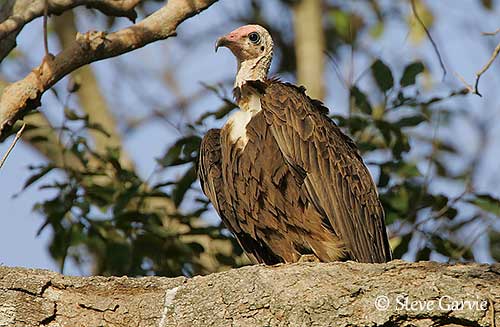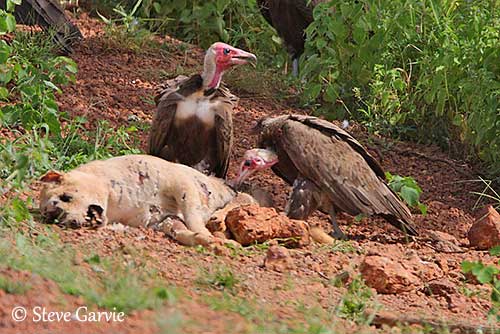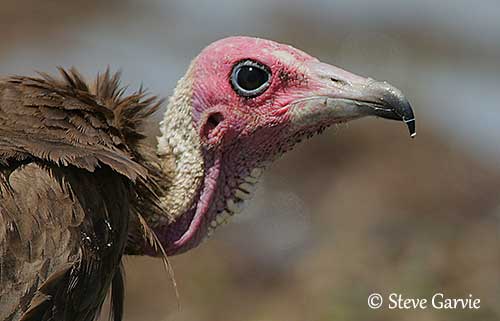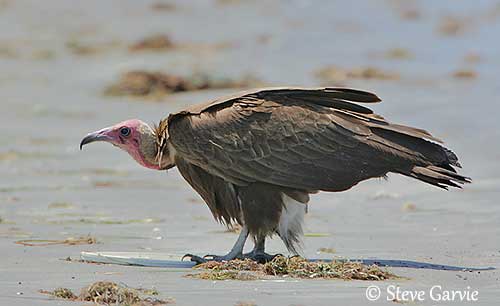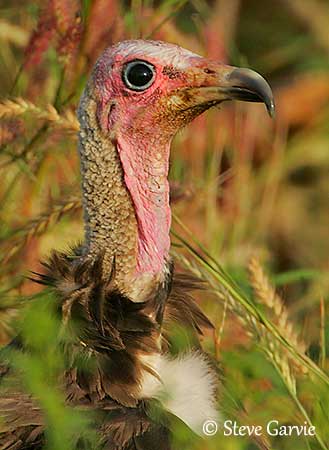
Hooded Vulture
Necrosyrtes monachus
Accipitriforme Order – Accipitridae Family
BIOMETRICS:
Length: 62-72 cm ; Wingspan: 155-165 cm ; Weight: 1500-2600 g
DESCRIPTION:
Hooded Vulture is one of the smallest and least vigorous among the vultures of its habitat. Female is slightly larger than male.
Adults have downy white feathers on the rear neck, forming a kind of hood on the head, with white collar. Face is usually greyish, but may turn bright pink, red or even bluish when excited. The colour of the bare skin in neck and head may change when blood vessels dilate in a highly excitation or aggressiveness state. This reaction is completely involuntary, and appears as an alarm for the other vultures. When it is frightened, its skin becomes pale or greyish white.
Hooded Vulture is entirely brown, and mainly the young, whereas in adults, white spots enhance the dark colours in places. Bill is long and narrow, making the bird easily identifiable.
In flight, its wings are shorter and broader, less pointed than in Egyptian Vulture. We can see six “fingers” at the tip of the wings, only five in Egyptian Vulture. It has squared tail, instead pointed, and it is entirely black. Adults have a diffuse pattern through the underwing, formed by pale flight feathers’ bases.
Juvenile resembles adults, but it has dark down from crown to nape, dark crop, pinkish grey face and throat skin, and any pattern on underwings.

VOICE: SOUNDS BY XENO-CANTO
Hooded Vulture adult is usually silent, but chicks peep to parents when they feed them.
HABITAT:
Hooded Vulture lives in forest clearings where strong rains fall, on coastal marshes and lagoons. We can also find it in towns and villages, visiting the dumps and slaughterhouses. We can also find it at up to 3000 metres of elevation, in forests edges.
RANGE:
This species lives south of the Sahara, Uganda, Kenya and Tanzania.
BEHAVIOUR:
Hooded Vulture, with its fine but vigorous bill, is able to remove flesh from bones, but it is more difficult for it to tear skin from carcasses. It often leaves the place to largest vultures which do this work for it. Its powerful toes are adapted for running and walking, but not for catching prey. This vulture has not choice, and has to add insects and refuses recovered in the cities, in order to feed.
More daring than most of other vultures, Hooded Vulture approaches human. A common and funny behaviour consists in following a plough, to take advantage of beautiful larvae and insects disturbed by the movement.
But as bold as it is with human, it is shyer than it appears. It is one of the most solitary vultures, but pairs remain together for life.
Courtship displays are not very spectacular, however, sometimes, either male swoops down on female, or it dances and describes circles on the ground, claws held out.
FLIGHT:
Hooded Vulture holds its wings like large vultures, when it rises, and in the same way, it drops them, making dark its body when on the ground. Because it is smaller than much of other vultures, it takes off more quickly, and it is often the first to find a carcass.
REPRODUCTION:
Hooded Vulture’s nest is built in a tree (often a Baobab tree), and it is reused year after year. It is very well lined with fresh vegetation during all the nesting season.
Female lays only one egg and remains very attentive. Incubation lasts about 48 to 54 days, shared by both parents, but mainly by female. She spends the most of its time sat on its egg in a careful way, and male feeds her at nest.
Chick is very weak at hatching, and requires a very constant attention from both parents, much more than other vultures. It will be dependent on them for seven months, after having got its whole plumage and performed its first flights.
DIET:
Hooded Vulture feeds on insects, bone and carrions.
PROTECTION/THREATS / STATUS:
Hooded Vulture is locally protected by the inhabitants, being considered as necessary. It lives easily close to humans.
LEGEND:
A legend told by YORUBA Tribe, in West Africa, tells that when dryness was rife, harvests perished. A sacrifice was decided, in order to implore the Storms’ God for sending rain.
A Ram was killed for the sacrifice, and put in a basket to be carried to the sky. All the birds were extremely busy, having any time to do this work. Finally, the vulture, that nobody liked, agreed to carry the offering of the sacrifice. And the rain fell on the Earth...
When the vulture returned, it found its nest emptied and destroyed. When it went to ask for assistance to the other birds, they turned their backs away to him, being unaware of its request.
Since this day, the vulture remained exile, feeding on garbage. And it remained bald because the fire of the sacrifice had burnt its head and neck’s feathers.
Since this period, Hooded Vulture was promoted Vulture cleaner by the royal family in Kumasi. It is now sacred and protected by the law.
Fr: Vautour charognard
All : Kappengeier
Esp : Alimoche Sombrío
Ital: Capovaccaio pileato
Nd: Kapgier
Russe: Бурый стервятник
Sd: Kappgam
Steve Garvie
RAINBIRDER Photo galleries & Flickr Rainbirder
Texte de Nicole Bouglouan
Sources:
HANDBOOK OF THE BIRDS OF THE WORLD Vol 2 by Josep del Hoyo-Andrew Elliot-Jordi Sargatal - Lynx Edicions - ISBN: 8487334156
BIRDS OF PREY OF AFRICA AND ITS ISLANDS by Alan and Meg Kemp - Struik Publishers - ISBN: 1770073698
BIRDS OF AFRICA SOUTH OF THE SAHARA by Ian Sinclair and Peter Ryan - Princeton University Press Princeton and Oxford - ISBN: 0691118159
Wikipedia (Wikipedia, The Free Encyclopedia)
The Hawk Conservancy Trust (Hilary Smith)
Other article: The Old World Vultures
